A Parametric Study of a Hybrid Photovoltaic Thermal (PVT) System Coupled with a Domestic Hot Water (DHW) Storage Tank
Abstract
1. Introduction
2. Methods and Materials
2.1. Numerical Model of a PVT System
2.2. Transient Model of a PVT System
- PVT collector Type 50d, modelled after DualSun Spring Hybrid panel. This type is a hybrid model that adds a PV module to the standard flat-plate collector. It simulates a combined collector and incorporates the analysis and work of Florschuetz [4] for flat plate collectors operated at peak power [26].
- Coiled Water Storage Tank Type 534. The tank was modelled after a commercial boiler Viessman Vitocell 340-M. It is a constant volume storage tank with immersed heat exchangers. This component models a cylindrical tank with a vertical configuration. The fluid in the storage tank interacts with the fluid in the immersed heat exchanger, with the environment (through thermal losses from the top, bottom and edges) and with the flow streams at the inlet and outlet of the storage tank [26].
- Controller Type 2b. The on/off differential controller generates a control function which can have a value of 1 or 0. The value of the control signal is chosen as a function of the difference between upper and lower temperatures Th and Tl, compared with two dead band temperature differences DTh and DTl. The new value of the control function depends on the value of the input control function at the previous timestep. The controller is normally used with the input control signal connected to the output control signal, providing a hysteresis effect [26].
- Circulation pump Type114. A single (constant) speed pump that is able to maintain a constant fluid outlet mass flow rate. It sets the downstream flow rate based on its rated flow rate parameter and the current value of its control signal input [26].
- Inverter/Regulator 48d. Models both the regulator and inverter, operates in Mode 1: Peak-power tracking collector, monitoring state of charge [26].
- Output online and offline printer Type 65c. The online graphics component is used to display selected system variables while the simulation is progressing. Data sent to the online plotter are automatically printed, once per time step, to a user defined external file [26].
- Forcing function for defining the demand curve Type 14h. This is a repeated pattern. The pattern of the forcing function is established by a set of discrete data points input by the user which indicate the value of the function at various times in a cycle. Linear interpolation is done for generating a continuous function from the discrete data [26].
- Weather data Type 15. It reads data from the Meteonorm database at regular time intervals, interpolating the data at the required timestep and transmits it to other TRNSYS components [26].
2.3. Parametric Analysis
3. Results and Discussion
3.1. Tank Inlet Temperature
3.2. Tank Volume
3.3. Flow Rate to Consumer
3.4. Various Demand Curves
3.5. Power vs. PVT Inlet Temperature
3.6. Discussion
4. Conclusions
- The lower the cold-water temperature of the main, the better the cell electrical efficiency.
- The bigger the water storage tank, the better the cell electrical efficiency.
- The higher the consumer water demand, the better the cell electrical efficiency.
- When there is a peak in the hot water demand from the consumer, the electrical efficiency of the cell also peaks.
- The biggest impact on the electrical efficiency is the water draw to the consumer.
- With increasing temperature of the fluid at the inlet of the PVT panel, the instantaneous electrical power decreases, the instantaneous thermal power also decreases, but the net instantaneous thermal power added to the tank increases.
- Mitigation measures for the cases when there is not sufficient hot water consumption to the user.
- Validation of model with an experimental system.
- An economic analysis of the parameters studied in this paper.
- Analysis of the coupling of a PVT system to a heat pump.
Author Contributions
Funding
Conflicts of Interest
Nomenclature
| efficiency | (%) | |
| T | temperature | (°C) |
| k | thermal conductivity | (W/mK) |
| δ | thickness | (m) |
| U | thermal loss coefficient | (W/(m2K)) |
| S | solar energy absorbed | (W) |
| Pel | electrical power | (W) |
| PthPVT | thermal power output by PVT | (W) |
| Pth_net_tank | net thermal power in the tank | (W) |
| A | area | (m2) |
| flow rate | (L/h) | |
| βr | temperature coefficient | (%/K) |
| absorptivity | (-) | |
| U | heat transfer coefficient | (W/(m2K)) |
| h | penalty factor [-] | (-) |
| PVT | photovoltaic thermal | |
| STC | standard testing conditions | |
| DHW | domestic hot water | |
| PV | photovoltaic | |
| ST | solar thermal | |
| CHP | combined heat and power | |
| PCM | phase change material | |
References
- Ramos, A.; Guarracino, I.; Mellor, A.; Alonso-Álvarez, D.; Childs, P.; Ekins-Daukes, N.; Markides, C. Solar-Thermal and Hybrid Photovoltaic-Thermal Systems for Renewable Heating; Grantham Institute Briefing paper No 22; Imperial College London: London, UK, 2017. [Google Scholar]
- Fahhad, A.; Kais, S. Theoretical Limits of Photovoltaics Efficiency and Possible Improvements by Intuitive Approaches Learned from Photosynthesis and Quantum Coherence. Renew. Sustain. Energy Rev. 2014, 43, 1073–1089. [Google Scholar]
- Dubey, S.; Sarvaiya, J.; Seshadri, B. Temperature Dependent Photovoltaic (PV) Efficiency and Its Effect on PV Production in the World–A Review. Energy Procedia 2013, 33, 311–321. [Google Scholar] [CrossRef]
- Florschuetz, L.W. 1979: Extenssion of the Hottel-Whillier Model to the Analysis of Combined Photovoltaic/Thermal flat plate collectors. Sol. Energy 1979, 22, 361–366. [Google Scholar] [CrossRef]
- Thilak Raj, N.; Iniyan, S.; Goic, R. A review of renewable energy based cogeneration technologies. Renew. Sustain. Energy Rev. 2011, 15, 3640–3648. [Google Scholar]
- Slimani, M.; Amirat, M.; Kurucz, I.; Bahria, S.; Hamidat, A.; Chaouch, W. A detailed thermal-electrical model of three photovoltaic/thermal (PV/T) hybrid air collectors and photovoltaic (PV) module: Comparative study under Algiers climatic conditions. Energy Conv. Manag. 2010, 133, 458–476. [Google Scholar] [CrossRef]
- Onovwiona, H.I.; Ugursal, V.I. Residential cogeneration systems: Review of the current technology. Renew. Sustain. Energy Rev. 2006, 10, 389–431. [Google Scholar] [CrossRef]
- Kern, E.C.J.; Russell, M.C. Combined photovoltaic and thermal hybrid collector systems. IEEE Photovolt. Spec. Conf. 1978, 1, 1153. [Google Scholar]
- Othman, M.Y.; Ruslan, M.H.; Alghoul, M.; Yahya, M.; Zaharim, A.; Ibrahim, A. Performance of photovoltaic thermal collector (PVT) with different absorbers design. WSEAS Trans. Environ. Dev. 2009, 5, 321–330. [Google Scholar]
- Leonforte, F.; Del Pero, C.; Aste, N. Design, modeling and performance monitoring of a photovoltaic–thermal (PVT) water collector. Sol. Energy 2015, 112, 85–99. [Google Scholar]
- Hermann, M.; Lunz, K.; Keyl, H.M.; Koch, L.; Stryi-Hipp, G. Fluid flow investigations of bionic absorbers made from aluminum and steel. In Proceedings of the EuroSun 2010 Conference, Graz, Austria, 28 September–1 October 2010. Abstract number 134. [Google Scholar]
- Chow, T.T. Performance analysis of photovoltaic-thermal collector by explicit dynamic model. Sol. Energy 2003, 75, 143–152. [Google Scholar] [CrossRef]
- Singh, I.; Singh, D.; Singh, M. Thermal Modeling and Performance Evaluation of Photovoltaic Thermal (PV/T) Systems: A Parametric Study. Int. J. Green Energy 2019, 16, 483–489. [Google Scholar] [CrossRef]
- Rejeb, O.; Dhaou, H.; Jemni, A. Parameters effect analysis of a photovoltaic thermal collector: Case study for climatic conditions of Monastir, Tunisia. Energy Convers. Manag. 2019, 89, 409–419. [Google Scholar] [CrossRef]
- Guarracino, I.; Mellor, A.; Ekins-Daukes, N.J.; Markides, C.N. Dynamic coupled thermal-and-electrical modelling of sheet-and-tube hybrid photovoltaic/thermal (PVT) collectors. Appl. Therm. Eng. 2016, 101, 778–795. [Google Scholar] [CrossRef]
- Kallio, S.; Siroux, M. Energy Analysis and Exergy Optimization of Photovoltaic-Thermal Collector. Energies 2020, 13, 5106. [Google Scholar] [CrossRef]
- Ma, T.; Zhao, J.; Li, Z. Mathematical modelling and sensitivity analysis of solar photovoltaic panel integrated with phase change material. Appl. Energy 2018, 228, 1147–1158. [Google Scholar] [CrossRef]
- Ijumba, P.; Sebitosi, A. Evaluating the impact of consumer behaviour on the performance of domestic solar water heating systems in South Africa. J. Energy S. Afr. 2010, 21, 25–34. [Google Scholar] [CrossRef]
- Nhut, L.; Raza, W.; Park, Y.A. Parametric Study of a Solar-Assisted House Heating System with a Seasonal Underground Thermal Energy Storage Tank. Sustainability 2020, 12, 868. [Google Scholar] [CrossRef]
- Arsalis, A.; Alexandrou, A. Parametric study and cost analysis of a solar-heating-and-cooling system for detached single-family households in hot climates. Sol. Energy 2015, 117, 59–73. [Google Scholar] [CrossRef]
- Khalilpour, K.; Vassallo, A. Technoeconomic parametric analysis of PV-battery systems. Renew. Energy 2016, 97, 757–768. [Google Scholar] [CrossRef]
- Tzinnis, S.; Bellos, E.; Tzivanidis, C. Parametric Analysis of a Solar Cooling System Designed for Athens Climate. In Proceedings of the 5th International Conference Energy in Buildings 2016 (EinB201), Athens, Greece, 12 November 2016. [Google Scholar]
- Tiwari, A.; Sodha, M.S. Performance evaluation of hybrid PV/thermal water/air heating system: A parametric study. Renew. Energy 2006, 31, 2460–2474. [Google Scholar] [CrossRef]
- Alobaid, M.; Hughes, B.; O’Connor, D.; Calautit, J.; Heyes, A. Improving Thermal and Electrical Efficiency in Photovoltaic Thermal Systems for Sustainable Cooling System Integration. J. Sustain. Dev. Energy Water Environ. Syst. 2018, 6, 305–322. [Google Scholar] [CrossRef]
- Barbu, M.; Darie, G.; Siroux, M. Analysis of a residential photovoltaic-thermal (PVT) system in two similar climate conditions. Energies 2019, 12, 3595. [Google Scholar] [CrossRef]
- TRNSYS 17-a. TRaNsient SYstem Simulation program. In Volume 4 Mathematical Reference; the Solar Energy Laboratory, University of Wisconsin-Madison: Madison, WI, USA, 2014. [Google Scholar]
- Jonas, D.; Lämmle, M.; Theis, D.; Schneider, S.; Frey, G. Performance modeling of PVT collectors: Implementation, validation and parameter identification approach using TRNSYS. Sol. Energy 2019, 193, 51–64. [Google Scholar] [CrossRef]
- Buonomano, A.; Calise, F.; Vicidomini, M. Design, Simulation and Experimental Investigation of a Solar System Based on PV Panels and PVT Collectors. Energies 2016, 9, 497. [Google Scholar] [CrossRef]
- Agudelo-Vera, C.; Avvedimento, S.; Boxall, J.; Creaco, E.; de Kater, H.; Di Nardo, A.; Djukic, A.; Douterelo, I.; Fish, K.; Iglesias Rey, P.; et al. Drinking Water Temperature around the Globe: Understanding, Policies, Challenges and Opportunities. Water 2020, 12, 1049. [Google Scholar] [CrossRef]
- Guarracino, I. Hybrid Photovoltaic-Thermal Solar Systems for Combined Heating. Ph.D. Thesis, Imperial College London, London, UK, 2017. [Google Scholar]
- Jordan, U.; Vajen, K. DHWcalc: Program to generate domestic hot water profiles with statistical means for user defined conditions. In Proceedings of the ISES Solar World Congress, Orlando, FL, USA, 6–12 August 2005. [Google Scholar]
- Jordan, U. Statistically Generated DHW-Load Profiles on a One-Miunte Time Scale; IEA SHACP Task 26; International Energy Agency: Paris, France, 2000. [Google Scholar]
- Tanaka, A.; Murakawa, S.; Koshikawa YAnd Takata, H. Calculation of hot water supply demands and instrument’s capacity for the guest rooms in a City hotel. J. Environ. Eng. 2008, 73, 69–75. [Google Scholar] [CrossRef]
- Chang, H.; Praskievicz, S.; Parandvash, H. Sensitivity of Urban Water Consumption to Weather and Climate Variability at Multiple Temporal Scales: The Case of Portland, Oregon. Int. J. Geosp. Environ. Res. 2014, 1, 7. [Google Scholar]
- Susanne, B. Water equity–Contrasting tourism water use with that of the local community. Wat. Res. Ind. 2014, 7–8, 9–22. [Google Scholar]
- Koiv, T.A.; Voll, H.; Hani, A. Domestic hot water consumption in educational premises, apartment and office buildings. Wseas Trans. Environ. Dev. 2010, 1, 54–63. [Google Scholar]

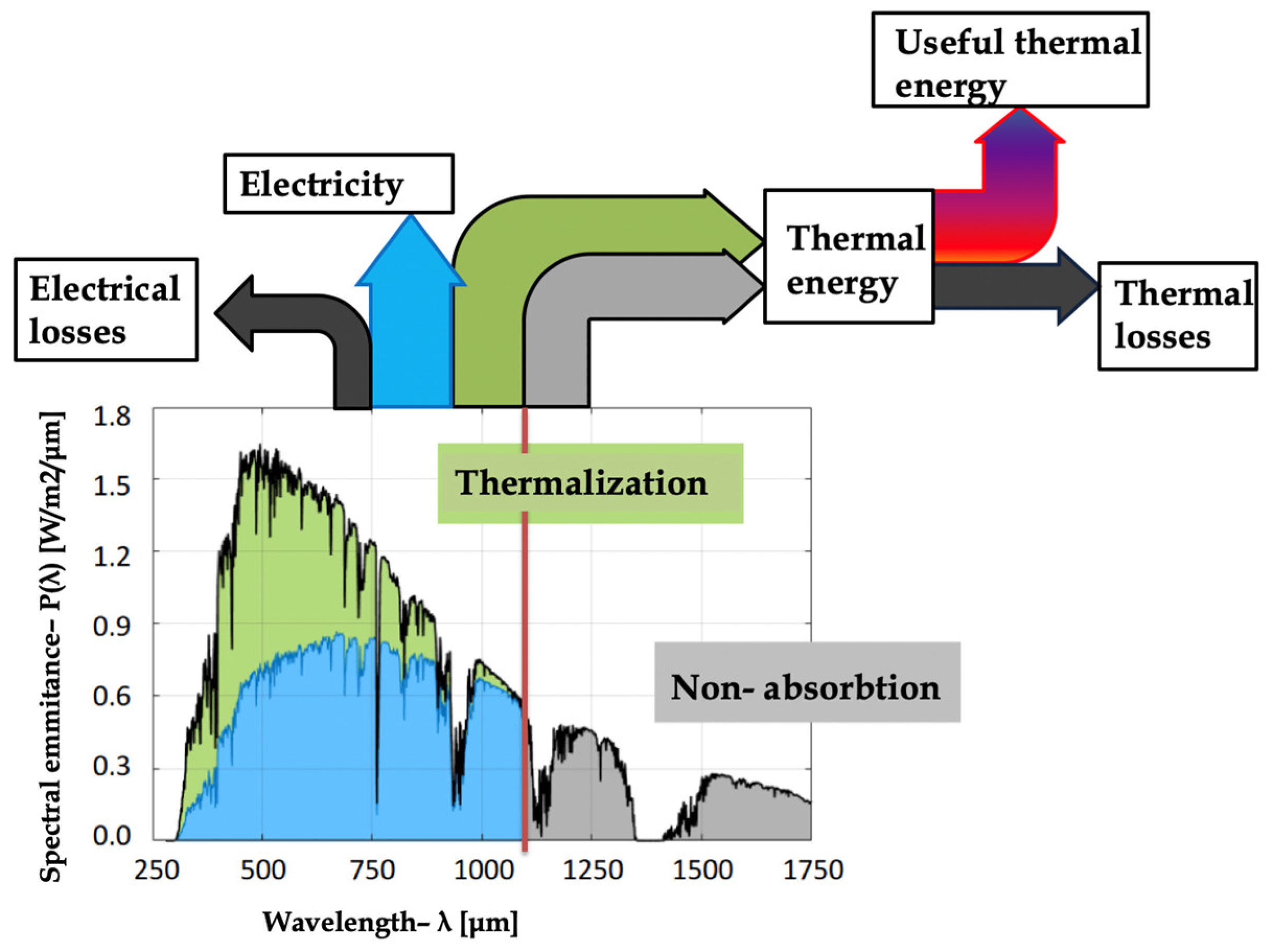

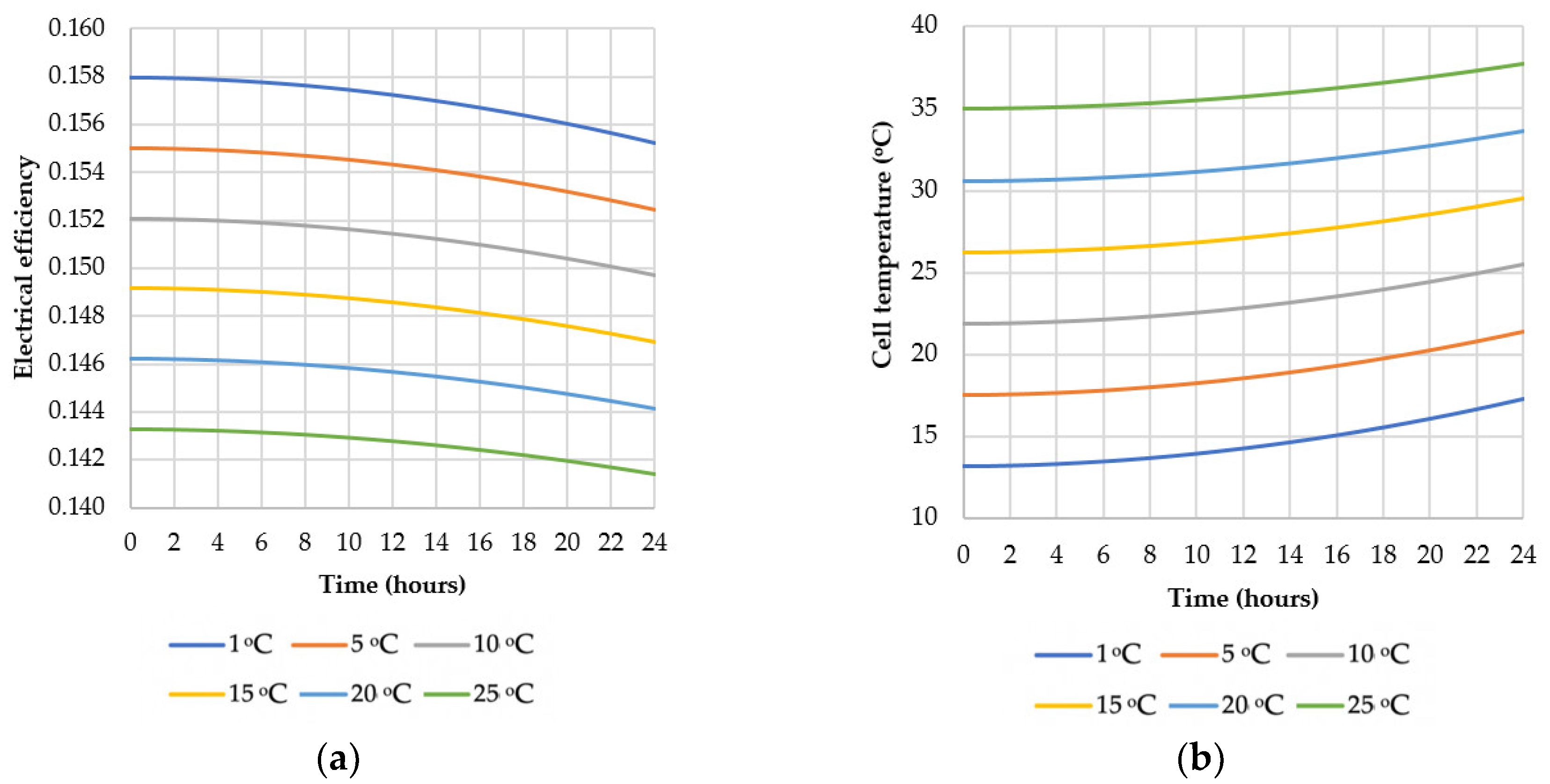

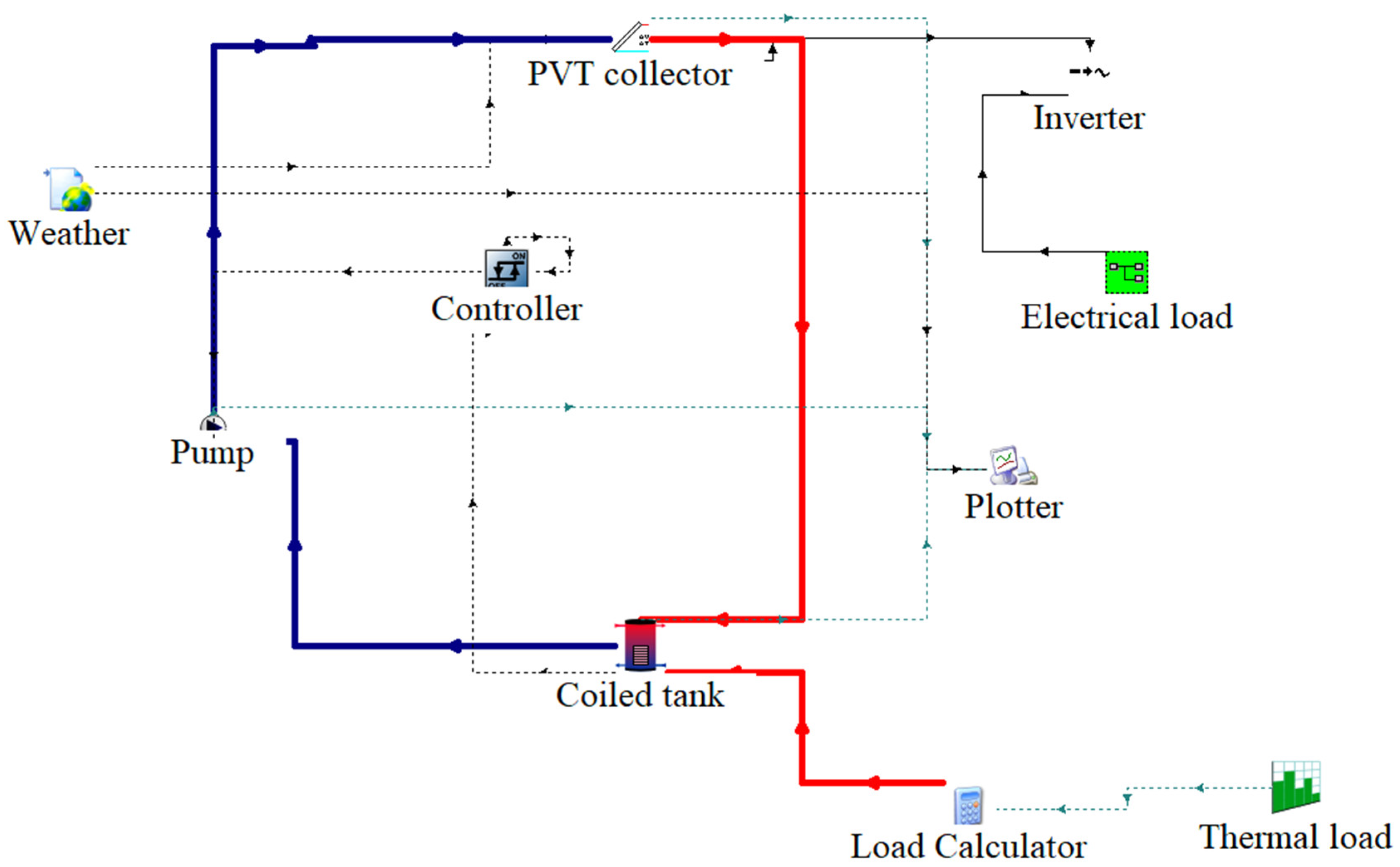
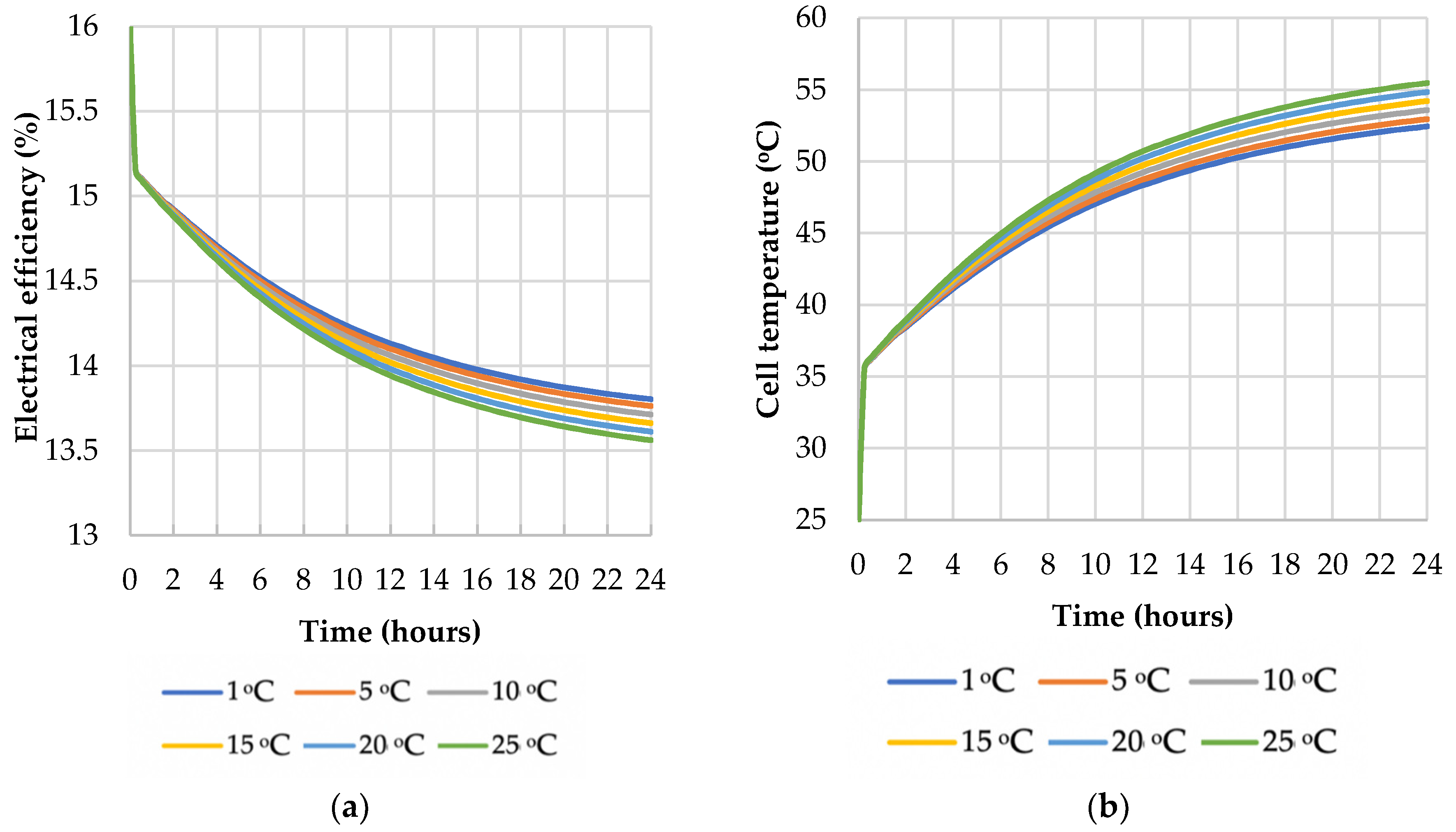
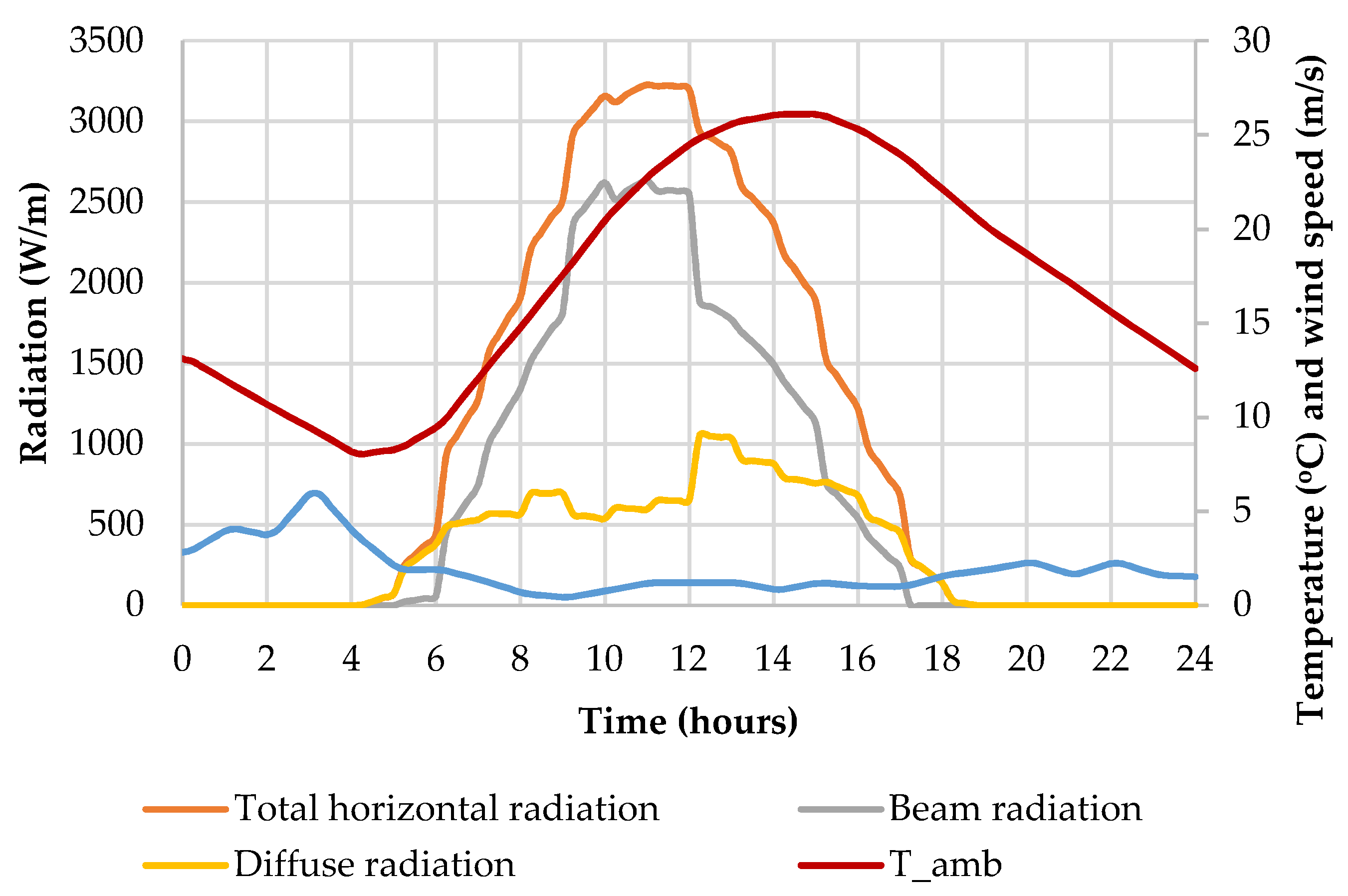
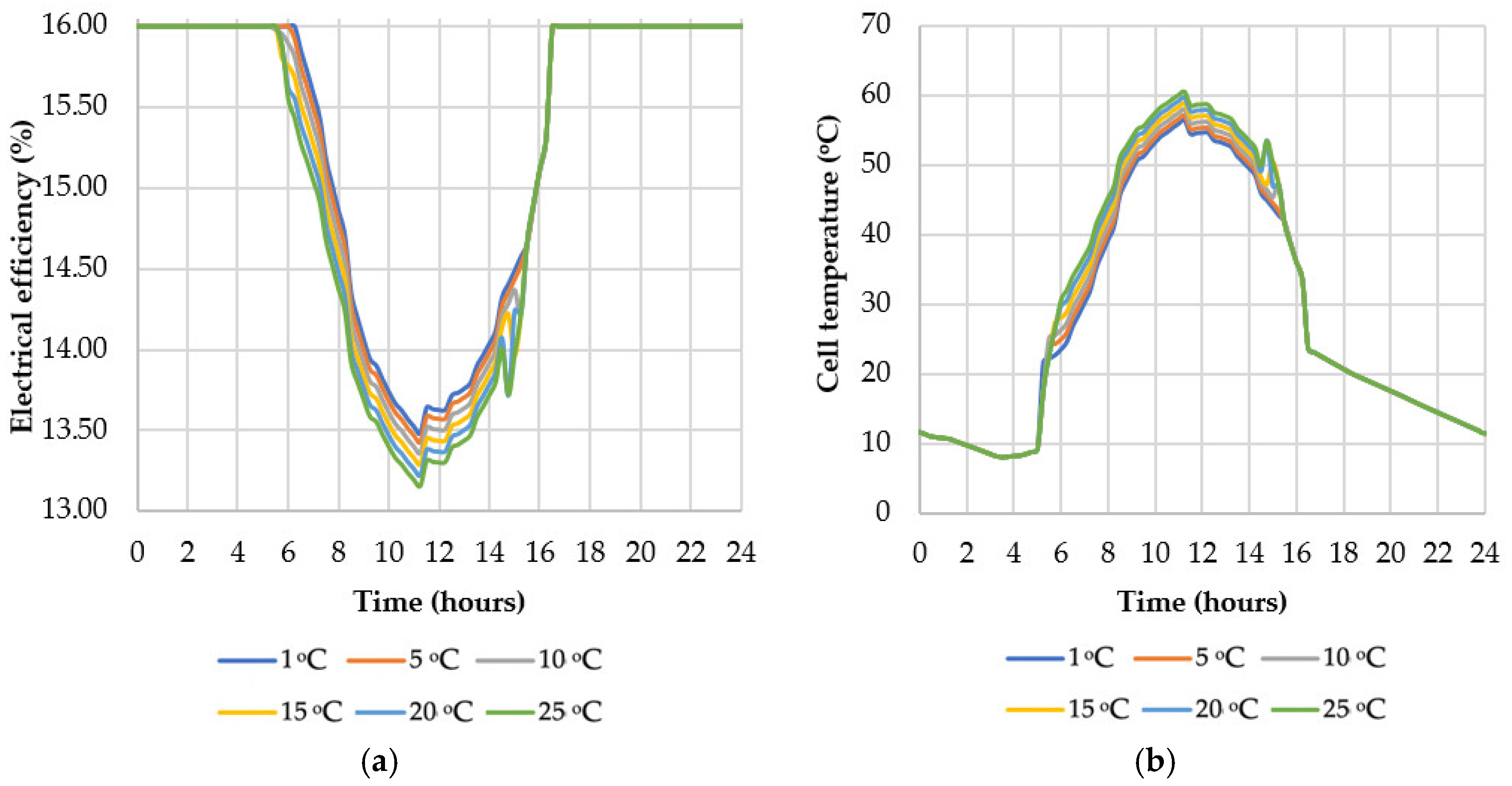
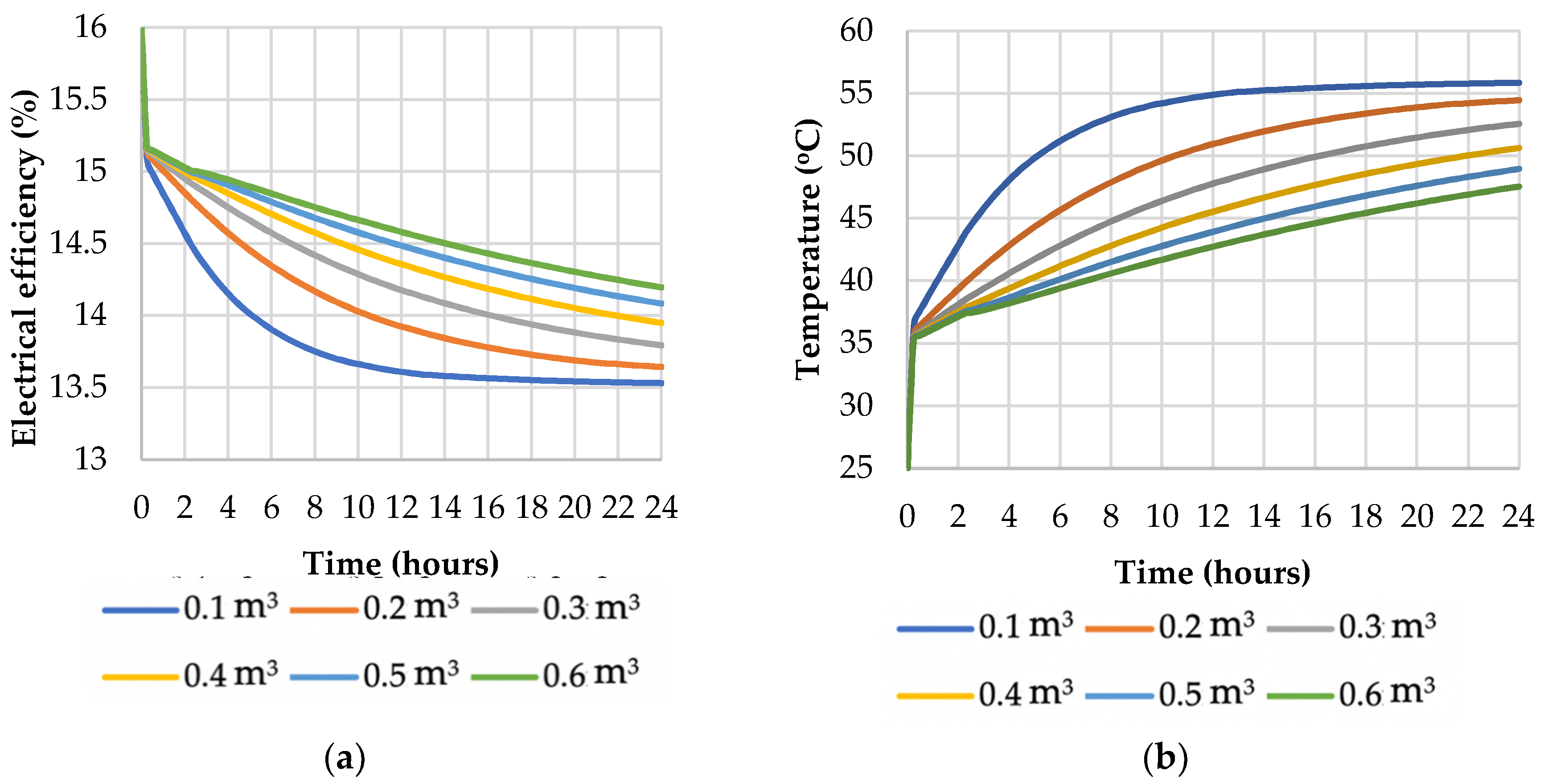
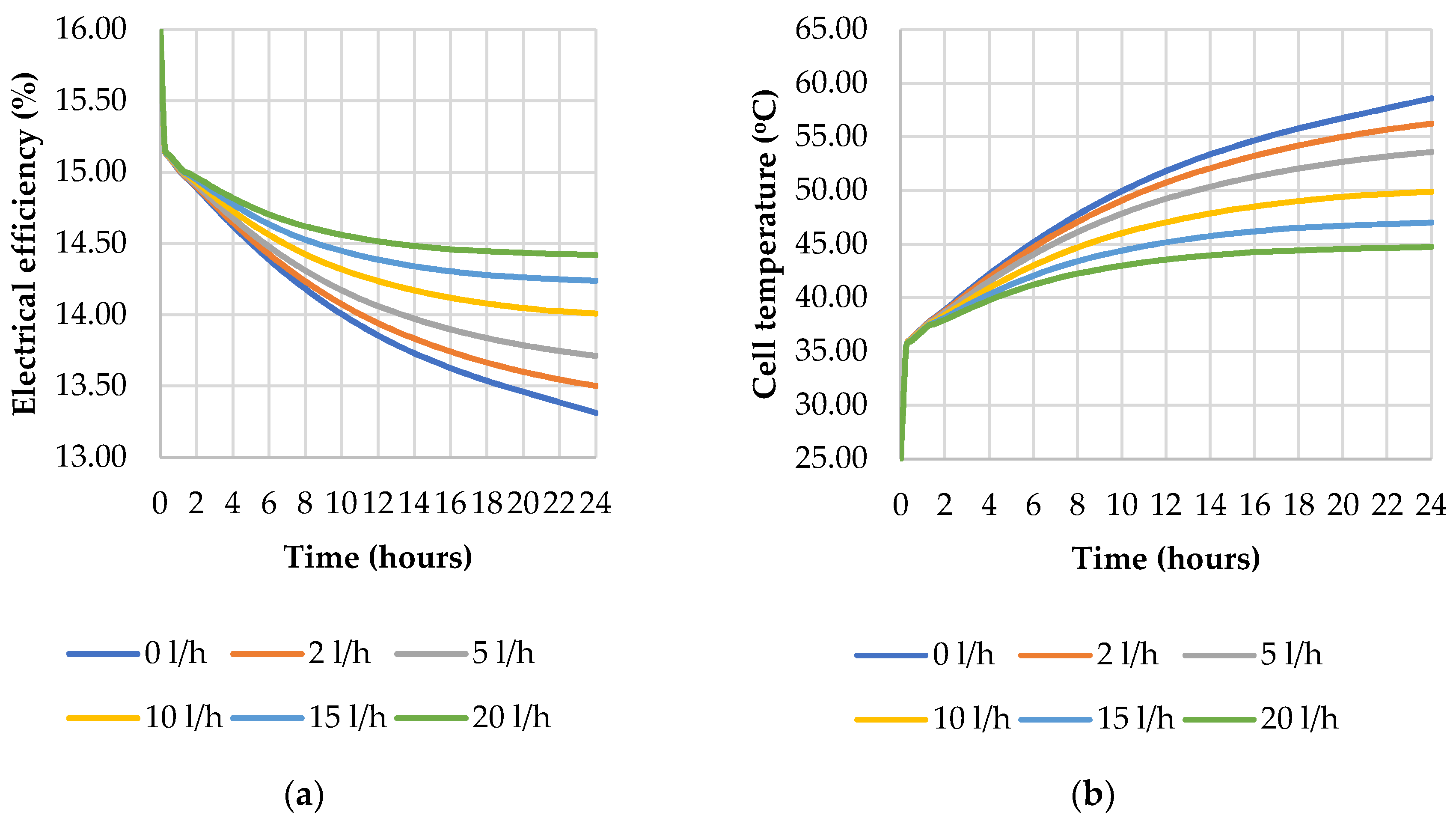
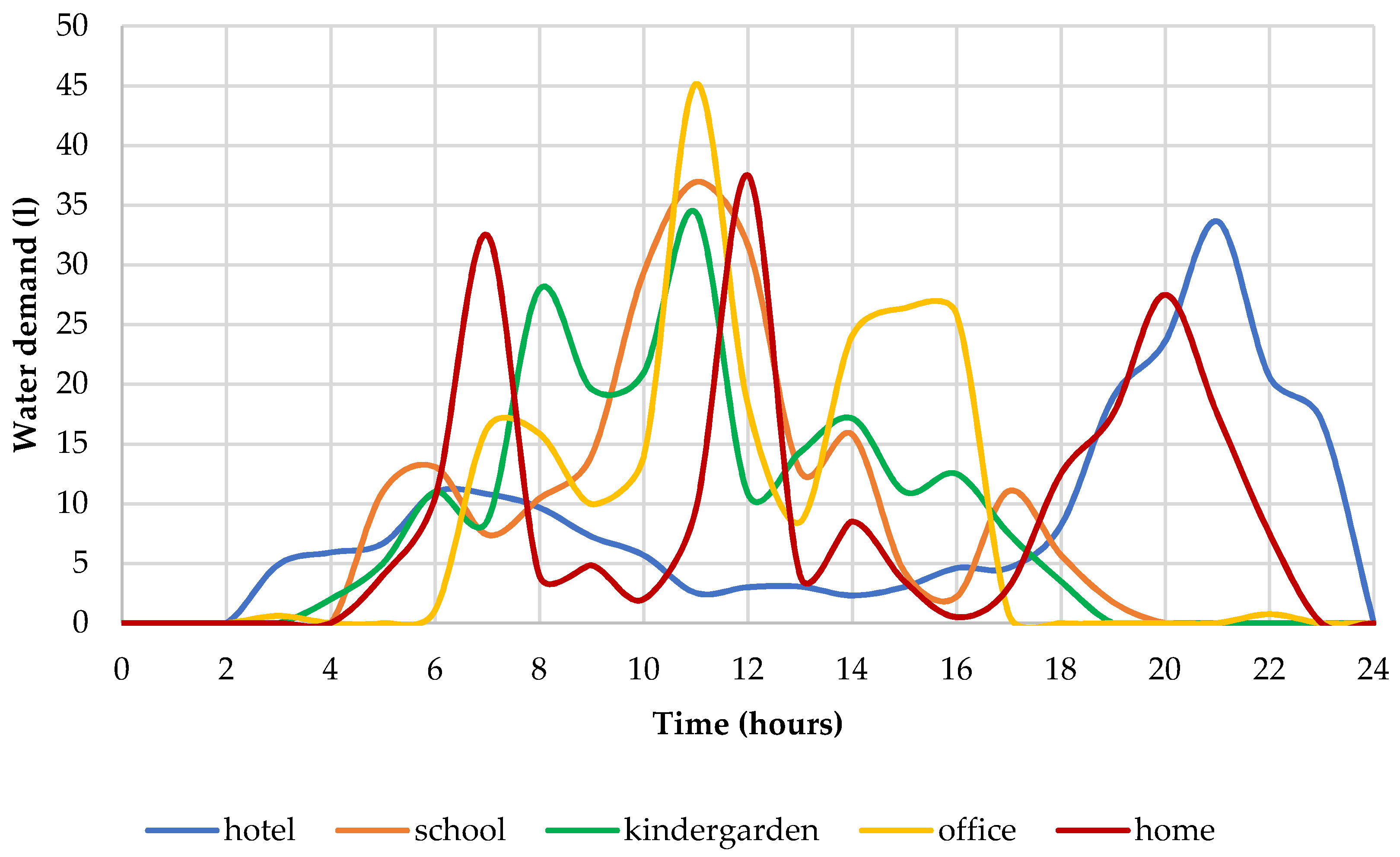
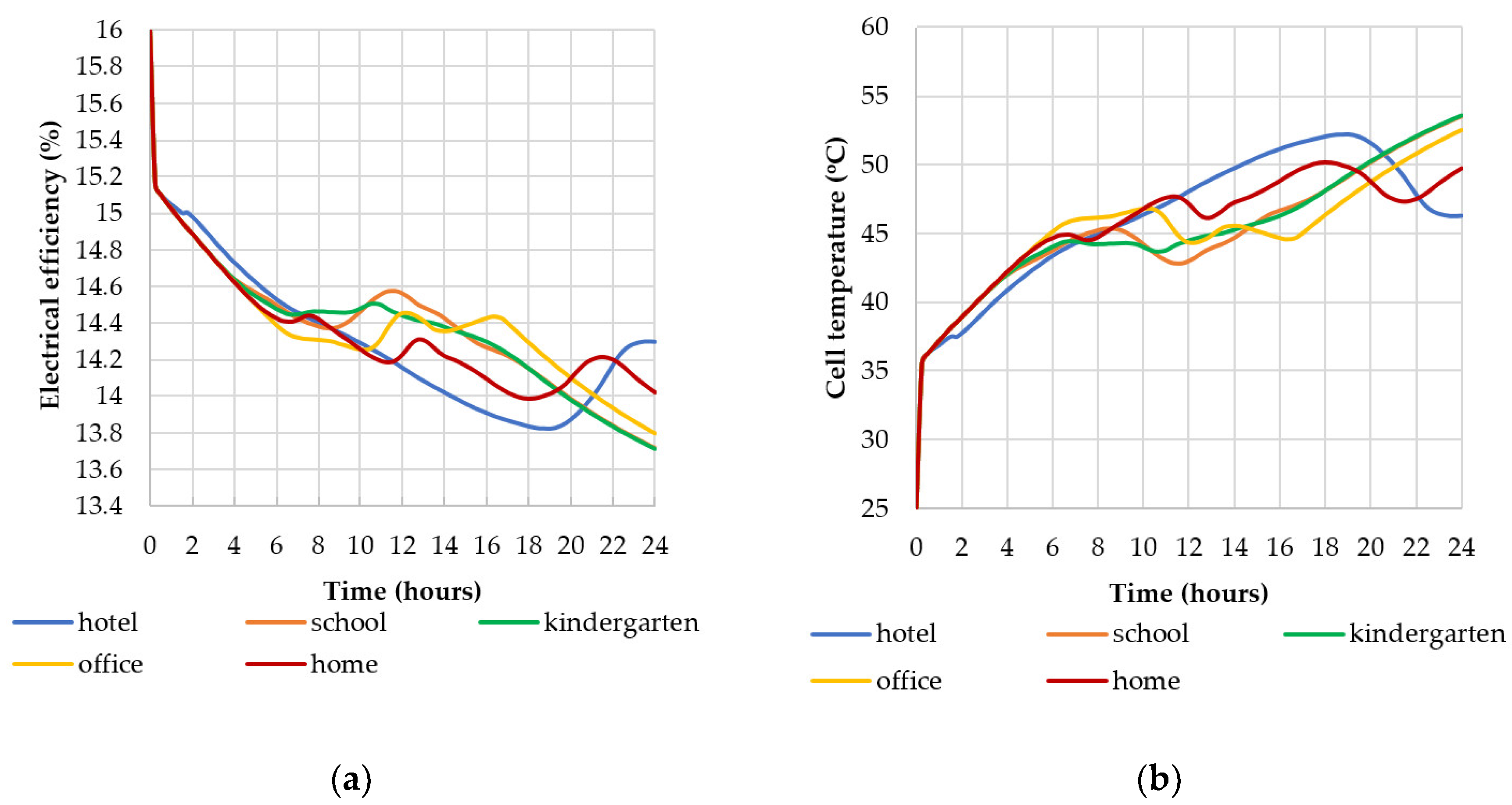


| Parameter | Notation | Value |
|---|---|---|
| Ambient Temperature | Ta | 25 °C |
| Solar Radiation | G | 1000 W/m2 |
| Wind speed | vw | 0 m/s |
| Reference electrical efficiency of cell | 16% | |
| Pump flow rate | pump | 200 L/h |
| PVT area | A | 3 m2 |
| Tank volume | Vtank | 250 L |
| Temperature coefficient | r | −0.5% |
| Tank outlet flow rate | out | 5 L/h |
| Tank inlet temperature | Tin | 7 °C |
| Parameter. | Range | Step |
|---|---|---|
| Tank inlet temperature | 1–25 °C | 5 °C |
| Tank outlet flow rate | 1–30 L\h | 5 L |
| Tank volume | 100–600 L | 100 L |
| Demand curve | refer to 4.4 | refer to 4.4 |
| Type of Building | Location of Measured Data | Reference |
|---|---|---|
| Home | Europe | [31,32] |
| Hotel | Japan | [33] |
| Kindergarten | Estonia | [36] |
| School | Estonia | [36] |
| Office | Estonia | [36] |
| Parameter | Variation | % Variation from Total | Annual Variation in Terms of Electrical Energy (kWh) |
|---|---|---|---|
| Tank inlet temperature | 0.242 | 1.514 | 17.76 |
| Tank outlet flow rate | 1.099 | 6.871 | 80.62 |
| Tank volume | 0.664 | 4.153 | 48.72 |
| Demand curve | 0.574 | 3.588 | 42.09 |
Publisher’s Note: MDPI stays neutral with regard to jurisdictional claims in published maps and institutional affiliations. |
© 2020 by the authors. Licensee MDPI, Basel, Switzerland. This article is an open access article distributed under the terms and conditions of the Creative Commons Attribution (CC BY) license (http://creativecommons.org/licenses/by/4.0/).
Share and Cite
Barbu, M.; Darie, G.; Siroux, M. A Parametric Study of a Hybrid Photovoltaic Thermal (PVT) System Coupled with a Domestic Hot Water (DHW) Storage Tank. Energies 2020, 13, 6481. https://doi.org/10.3390/en13246481
Barbu M, Darie G, Siroux M. A Parametric Study of a Hybrid Photovoltaic Thermal (PVT) System Coupled with a Domestic Hot Water (DHW) Storage Tank. Energies. 2020; 13(24):6481. https://doi.org/10.3390/en13246481
Chicago/Turabian StyleBarbu, Madalina, George Darie, and Monica Siroux. 2020. "A Parametric Study of a Hybrid Photovoltaic Thermal (PVT) System Coupled with a Domestic Hot Water (DHW) Storage Tank" Energies 13, no. 24: 6481. https://doi.org/10.3390/en13246481
APA StyleBarbu, M., Darie, G., & Siroux, M. (2020). A Parametric Study of a Hybrid Photovoltaic Thermal (PVT) System Coupled with a Domestic Hot Water (DHW) Storage Tank. Energies, 13(24), 6481. https://doi.org/10.3390/en13246481





